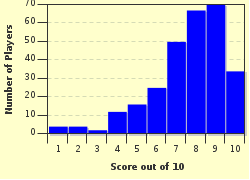Quiz Answer Key and Fun Facts
1. There are some unusual modes of dismissal of a batsman in cricket - they don't happen often, but are there nevertheless. Which one of these ISN'T a mode of dismissal in cricket?
2. Towards the end of the 20th Century, a new piece of protective clothing became widely adopted in cricket - what was it?
3. Why did the match between England and South Africa in March 1939 come to a premature end?
4. By what nickname are the New Zealand cricket known?
5. Which of these is NOT a "guard" taken by a batsman?
6. What animal(s) caused an interruption in an England v Sri Lanka Test match in Kandy in December 2007?
7. What is (statistically) the most common mode of dismissal for a batsman in cricket?
8. When a one day, limited overs match is interrupted by the weather, what is the name of the statistical system used to recalculate victory targets for the side batting second?
9. Which of these overs formats has NOT been seen in International cricket matches?
10. Whilst it is acknowledged that the first formal cricket teams were established in England in the first half of the 18th Century, what country is credited with being the next to form cricket clubs who played each other regularly?
Source: Author
huw27
This quiz was reviewed by FunTrivia editor
Dalgleish before going online.
Any errors found in FunTrivia content are routinely corrected through our feedback system.

